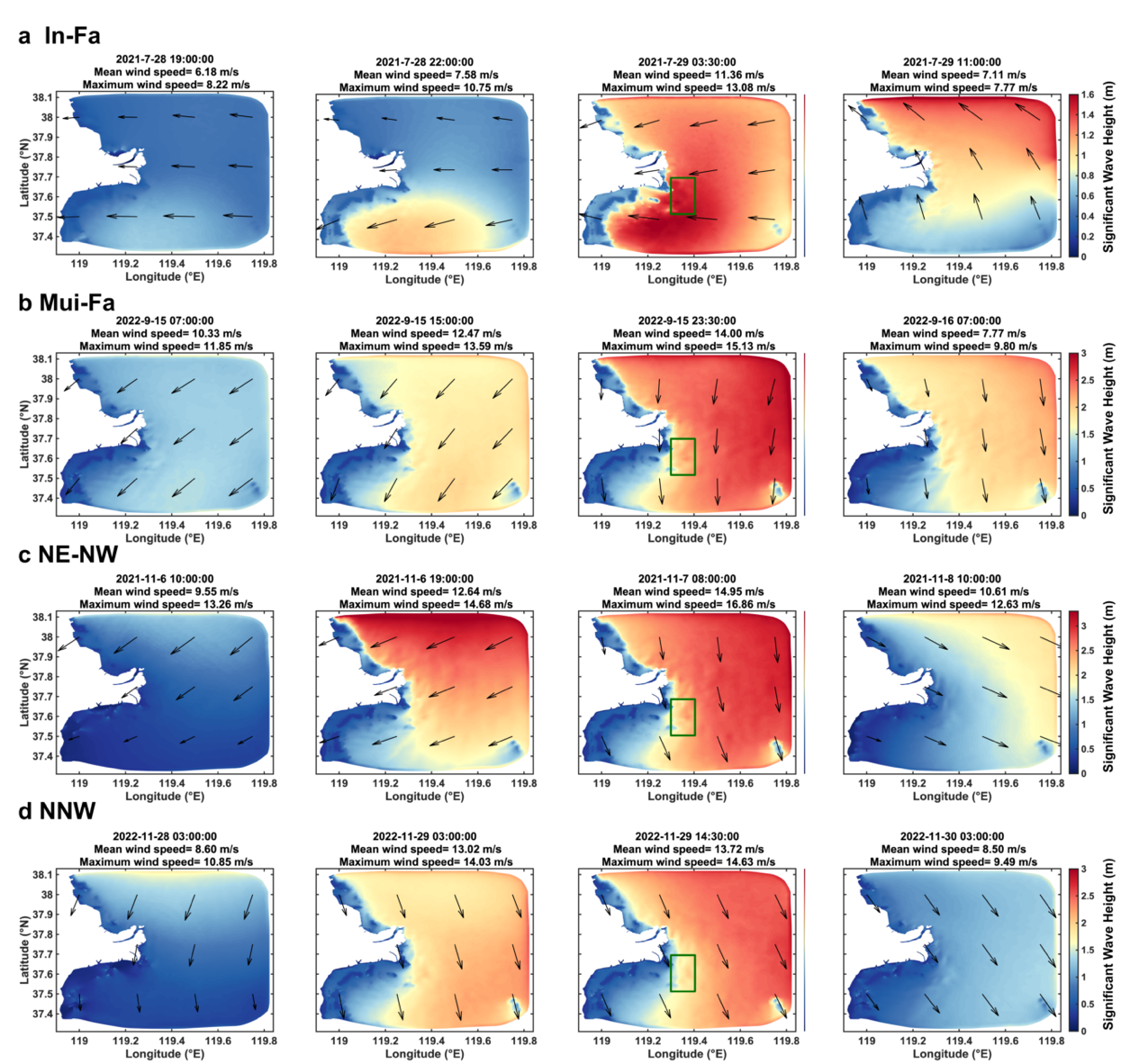| Research |
| Location:Home > Research > Research Progress |
| New Progress in the Yellow River Estuary Wave Dynamics under Typhoon and Cold Wave Events |
Estuarine deltas, as key zones of river-land-ocean interactions, play an important role in carbon storage and carbon neutrality, and are also among the most vulnerable coastal ecosystems. In recent years, under the influence of global warming, typhoon intensity has significantly increased and shown a trend of poleward migration. Meanwhile, the frequency of extreme cold wave events has risen, posing severe challenges to estuarine deltas in mid to high latitudes. The Yellow River Estuary, located between Bohai Bay and Laizhou Bay, has formed through the deposition of large volumes of sediment carried by the Yellow River. Its shallow-water and tidal flat geomorphology makes it highly susceptible to hazardous ocean waves. Wave dynamics have a significant impact on nearshore water levels, current fields, and sediment transport. Therefore, studying wave field variations under different extreme events is of great importance for maintaining the health and stability of the coastal environment in the Yellow River Estuary. Recently, Dr. Miaohua Mao’s research team from the Yantai Institute of Coastal Zone Research, Chinese Academy of Sciences, conducted relevant studies on extreme wave processes in the nearshore waters of the Yellow River Estuary. Based on the third-generation wave model SWAN (Simulating Waves Nearshore), and combined with marine observation data, the team used a double-nested unstructured SWAN model to simulate wave conditions (Fig. 1), sea states (Fig. 2), and wave energy variations (Fig. 3) during Typhoon In-Fa (2021), Typhoon Mui-Fa (2022), and two cold wave events in 2021 and 2022 (Gao et al., 2025). The key findings are as follows:
Fig. 1. Spatiotemporal distribution of significant wave height during (a) Typhoon In-Fa (2021), (b) Typhoon Mui-Fa (2022), cold wave events in (c) 2021 and (d) 2022.
Fig. 2. Tempral variation of wave age during (a) Typhoon In-Fa (2021), (b) Typhoon Mui-Fa (2022), cold wave events in (c) 2021 and (d) 2022.
Fig. 3. Spatial distribution of wave energy dissipation during (a) Typhoon In-Fa (2021), (b) Typhoon Mui-Fa (2022), cold wave events in (c) 2021 and (d) 2022. This study systematically reveals the characteristics of wave dynamic processes in the nearshore shallow-water estuarine delta and provides important theoretical insights into wave responses under extreme events. It also offers scientific support for nearshore environmental evolution studies and coastal engineering in deltaic regions, demonstrating both academic value and practical application potential. The related results have been published in the Ocean Modeling (Gao et al., 2025). The first author of the article is Shenghan Gao, a master's student at the Yantai Institute of Coastal Zone Research, and the corresponding author is Dr. Miaohua Mao (mhmao@yic.ac.cn). Co-authors include Professor Meng Xia from the University of Maryland. This research was supported by the National Natural Science Foundation of China(42050410325), Yantai’s “Double Hundred Plan”(E039031101), and the Key R&D Program of Shandong Province(2022CXPT019). Publication Information: Gao, S., Mao, M.*, & Xia, M. (2025). Wave dynamics in the Yellow River Estuary during cold wave and typhoon events. Ocean Modelling, 102568. https://doi.org/10.1016/j.ocemod.2025.102568 Related Publications: Su, C., Sahoo, B. *, Mao, M., & Xia, M. (2025). Machine learning techniques for predicting typhoon‐induced storm surge using a hybrid wind field. Journal of Geophysical Research: Machine Learning and Computation, 2, e2024JH000507. https://doi.org/10.1029/2024JH000507 Peng, J., Mao, M.*, & Xia, M. (2024). Wave Spectra Analysis on the Spatiotemporal Variability of Sea States under Distinct Typhoon Tracks in a Semienclosed Sea. Journal of Physical Oceanography, 54(3), 783-807. https://doi.org/10.1175/JPO-D-23-0066.1 Peng, J., Mao, M.*, & Xia, M. (2023). Dynamics of wave generation and dissipation processes during cold wave events in the Bohai Sea. Estuarine, Coastal and Shelf Science, 280, 108161. https://doi.org/10.1016/j.ecss.2022.108161 Nguyen, Q. T., Mao, M.*, & Xia, M. (2023). Numerical Modeling of Nearshore Wave Transformation and Breaking Processes in the Yellow River Delta with FUNWAVE-TVD Wave Model. Journal of Marine Science and Engineering, 11(7), 1380. https:// doi.org/10.3390/jmse11071380 |
| Appendix Download |
|
|


